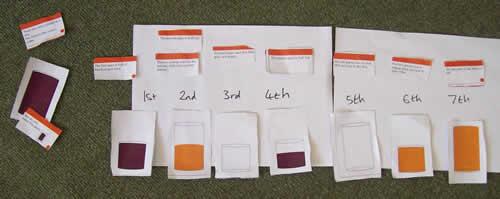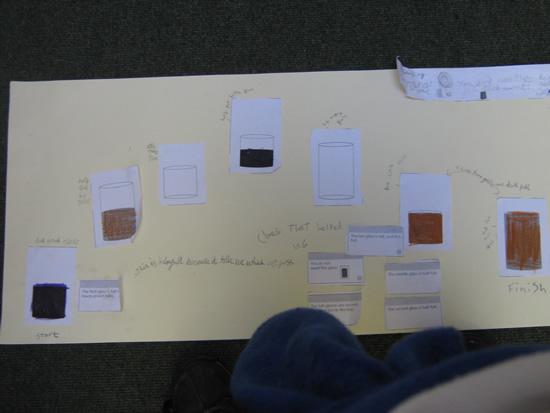Thirsty?
This problem has been designed to work on in a group of about four. For more details about how you might go about doing this, please read the
Teachers' Notes.
You will need to print off
these eight cards, which have pictures of glasses of orange and blackcurrant juice on them. You need one set of these cards for your group
Have a good look at the cards with everyone in your group. Talk to each other about what you notice. Can you sort the cards in different ways?
Now you are ready for the challenge. You will need to print off
this set of clue cards'. There are ten clue cards altogether.
Give the clue cards out to everyone in your group. Take it in turns to read your cards out loud. Listen out for instructions that tell you what to do, which are written on one or more of the cards.
Can you lay out the pictures of the drinks in the way described by the clue cards?
We would love to hear how you got on with this activity.
Perhaps you can send us a photo of your solution?
Can you tell us which clue cards helped you get started?
How did you know whether your solution was correct?
This activity is taken from Maths Buzz, collaborative reasoning challenges devised by NRICH and published by BEAM. Maths Buzz is out of print but can still be found on Amazon.
Why do this problem?
In
this problem learners need to coordinate three pieces of information about each glass: what it contains (orange or grape juice); how much it contains (full, half full or empty) and its height (tall or short). Through productive mathematical talk, the group will be developing their logical reasoning skills.
This problem lends itself to collaborative working, both for children who are inexperienced at working in a group and children who are used to working in this way. By working together on this problem, the task is shared and therefore becomes more manageable than if working alone.
Many NRICH tasks have been designed with group work in mind.
Here we have gathered together a collection of short articles that outline the merits of collaborative work, together with examples of teachers' classroom practice.
Possible approach
This is an ideal problem for learners to tackle in groups of four. Allocating these clear roles (
doc,
pdf) can help the group to work in a purposeful way - success on this
task could be measured by how effectively the group works together as well as by their final solution. This version of the roles has been adapted for primary children. You may want to alter the names of the roles for young children, but on the other hand,
many may enjoy getting to grips with important-sounding titles!Introduce the four group roles to the class. It may be appropriate, if this is the first time the class has worked in this way, to allocate particular roles to particular children. If the class works in roles over a series of lessons, it is desirable to make sure everyone experiences each role over time.
For suggestions of team-building maths tasks for use with classes unfamiliar with group work, take a look at
this article and the accompanying resources.
Each group of four will need a copy of these cards, which have pictures of glasses of juice on them (
doc,
pdf). Begin by giving the groups time to become
familiar with the cards. You could ask them to talk about what they notice. What is the same and different about the pictures? Can they sort the cards in different ways? Bring the whole class together to share some of these initial ideas. This is a great chance to introduce some of the vocabulary that will come up on the clue cards, such as 'full', 'half full', 'empty', 'short', 'tall', 'not
tall', 'not short', 'taller', 'shorter' etc.Now give each group a set of
these ten clue cardsdoc pdf wh
ich should be shared between all members of the group. Ask the children to read through the cards in turn - this
may need adult support, depending on their confidence with reading. You may choose to tell them that the cards with spots on them are the ones to start with, or you may prefer to leave them to work this out for themselves. You could explain that the groups will feed back at the end of the session, sharing the ways they worked, what helped them and what got in the way. You could give each group a
large sheet of flipchart paper on which to blutak the pictures of glasses but also the clue cards in the order in which they were used. They could also use this paper to make a note of anything significant as they go along. (Again, an adult might help with this aspect of the task.)Give the groups time to arrange the cards according to the clues. Remind them about preparing for feedback and keep them informed about how long they have left.
In the plenary, you could start by pinning up each group's large sheet so that the whole class can compare the order in which the groups have used the clue cards as well as comparing their solutions.
Key questions
If your focus is effective group work, this list of skills may be helpful (
Word,
pdf). Ask learners to identify which skills they demonstrated, and which skills they need to develop further;
or ask them to identify someone else in the group who demonstrated a particular skill.If your focus is mathematical, these prompts might be useful:
How are the cards alike?
How are the cards different?
What do your clues say?
What do we have to do with the pictures of the glasses?
Who has a good clue to start on?
Can you explain that clue in your own words?
Let's check over the clues we've used.
Do you think we've got the glasses in the right order? How do you know?
Possible extension
This set of clue cards can be used with the same picture cards but finding the arrangement of the glasses requires more sophisticated reasoning.
Possible support
Some groups may find it helpful to have a set of cards labelled 1st to 8th. You can print out
this set or simply use small pieces of paper. These files doc or
pdf can be used with the same picture cards but finding the arrangement of the glasses requires less sophisticated reasoning.



